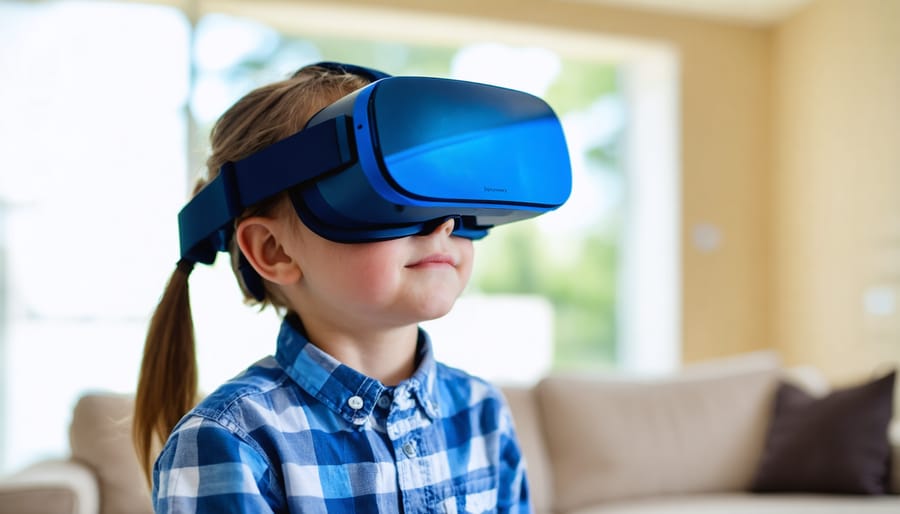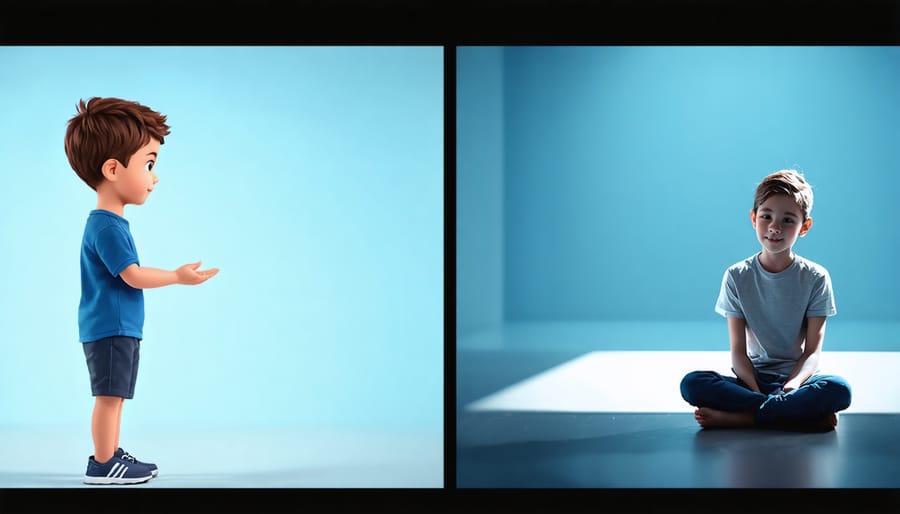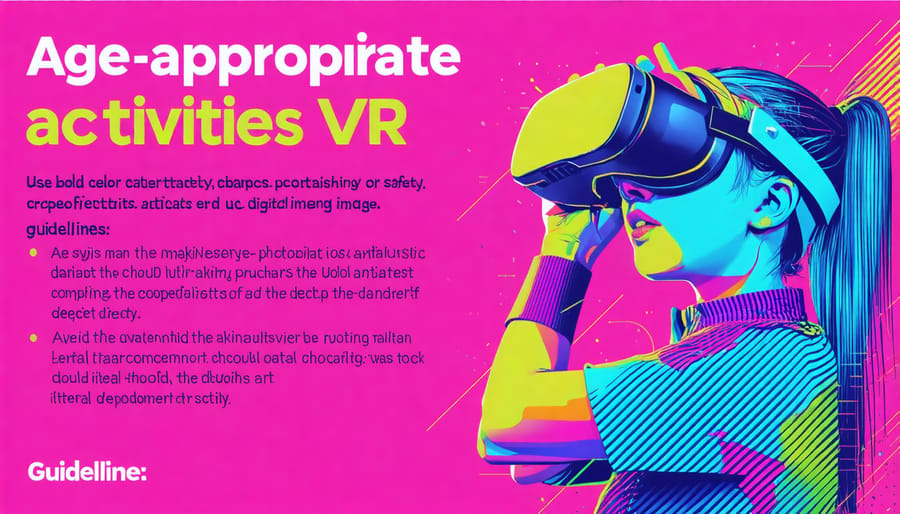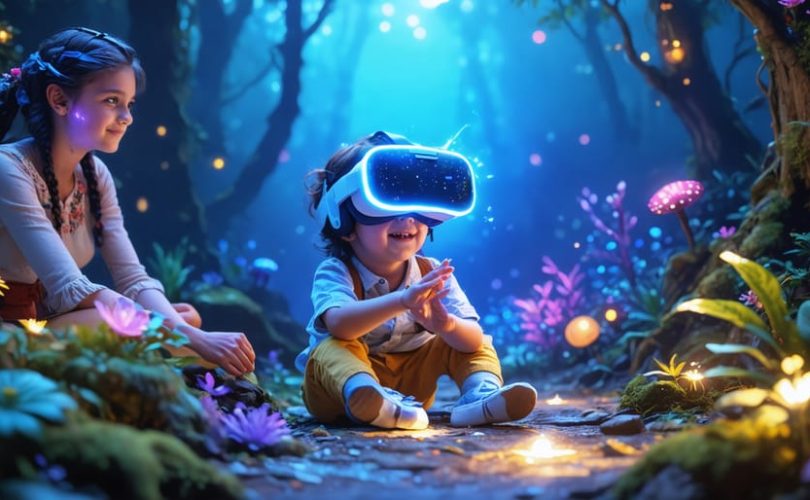Virtual reality is revolutionizing how children learn, creating immersive experiences that transform abstract concepts into tangible, interactive realities. As one of the most promising digital mental health tools, VR technology enables students to explore ancient civilizations, dissect virtual organisms, and practice social skills in safe, controlled environments. Research from Stanford’s Virtual Human Interaction Lab demonstrates that VR learning experiences can increase retention rates by up to 75% compared to traditional methods, while simultaneously developing crucial emotional intelligence and empathy skills.
For educators and parents, VR represents more than just another technological advancement – it’s a gateway to experiential learning that adapts to each child’s unique needs and learning style. Children with attention challenges often demonstrate increased focus and engagement when learning through VR, while those with anxiety can practice coping strategies in realistic but non-threatening scenarios.
The beauty of VR learning lies in its ability to make the impossible possible: students can walk through the human bloodstream, witness historical events firsthand, or practice public speaking in front of a virtual audience. This technology breaks down geographical and physical barriers, offering equal access to extraordinary educational experiences for children regardless of their location or circumstances.
How VR Creates Safe Spaces for Emotional Learning

The Power of Immersive Experiences
When children engage in virtual reality experiences, they don’t just see and hear – they feel like they’re truly there. This powerful sense of presence makes VR uniquely effective for emotional learning. As Dr. Sarah Chen, a child psychologist, explains, “When children feel physically present in a situation, their emotional responses become more authentic and meaningful.”
Think of it like the difference between watching someone ride a bicycle versus actually getting on one yourself. In VR, children can safely experience challenging social scenarios, practice emotional responses, and develop empathy by literally walking in someone else’s shoes. This immersive quality helps form stronger neural pathways, making the learning more likely to stick.
A recent study found that children who practiced emotional regulation skills in VR showed 40% better retention compared to traditional learning methods. The immersive nature of VR creates what educators call “experiential anchors” – powerful memory hooks that connect emotions to actions and consequences in a way that’s both engaging and lasting.
For children who struggle with traditional learning approaches, this immersive quality can be particularly transformative, offering a new pathway to emotional understanding and growth.
Building Confidence Through Virtual Practice
Virtual reality provides a safe, controlled environment where children can practice managing their emotions without real-world consequences. Like training wheels on a bicycle, VR scenarios allow kids to build confidence gradually while developing crucial emotional skills.
Dr. Sarah Chen, a child psychologist, explains: “When children practice emotional responses in VR, they can pause, reset, and try different approaches until they find what works best for them. This builds both competence and confidence.”
Through virtual scenarios, children can encounter challenging situations – like public speaking, conflict resolution, or handling disappointment – and experiment with different coping strategies. The immersive nature of VR helps kids feel present in the moment while maintaining awareness that they’re in a safe space.
Parents often report significant improvements in their children’s real-world emotional responses after regular VR practice sessions. “My son used to freeze up during class presentations,” shares Monica, mother of a 10-year-old. “After practicing in VR, he’s much more confident speaking in front of his classmates.”
Remember that VR practice should always be supervised and age-appropriate, serving as a complement to real-world emotional learning rather than a replacement.
Real Benefits for Common Emotional Challenges
Managing Anxiety and Fear
Virtual reality has emerged as a powerful emotional support technology for helping children face their fears and manage anxiety in a controlled, safe environment. Through carefully designed VR experiences, children can gradually confront challenging situations while feeling secure and supported.
For example, a child with social anxiety might practice giving presentations in a virtual classroom, where they can control the number of virtual students and the complexity of the situation. Similarly, children with specific phobias, such as fear of heights or animals, can work through their concerns step by step in realistic but non-threatening virtual scenarios.
What makes VR particularly effective is its ability to create immersive experiences that feel real enough to trigger emotional responses while maintaining a sense of safety. Parents and therapists can monitor progress and adjust the intensity of experiences to match each child’s comfort level. This gradual exposure helps build confidence and coping skills that transfer to real-world situations.
Dr. Sarah Chen, a child psychologist, notes, “VR provides a bridge between traditional therapy and real-world exposure, allowing children to develop resilience at their own pace.”
Developing Empathy
Virtual reality offers a unique way for children to step into someone else’s shoes and experience the world from different perspectives. Through immersive VR scenarios, children can witness various emotional situations and observe how their actions impact others, fostering genuine empathy and emotional understanding.
For example, when a child experiences a virtual scenario of being the new student at school, they gain firsthand insight into the feelings of uncertainty and nervousness that come with that situation. This experiential learning helps them recognize and relate to similar emotions in their real-world peers.
Dr. Sarah Chen, a child psychologist specializing in social-emotional development, notes that “VR creates safe spaces for children to practice emotional responses and develop compassion without real-world consequences.” Children can interact with virtual characters displaying different emotions, learn to recognize facial expressions and body language, and practice appropriate responses.
Studies show that children who participate in VR empathy training demonstrate improved emotional awareness and show more supportive behaviors toward their peers. These virtual experiences help bridge the gap between understanding emotions intellectually and feeling them personally, creating lasting impact on children’s social development.

Handling Strong Emotions
Virtual reality offers innovative ways to help children manage and understand their strong emotions in a safe, controlled environment. Through immersive experiences, children can practice emotional regulation techniques while feeling supported and engaged.
Dr. Sarah Chen, a child psychologist specializing in digital therapeutics, explains, “VR creates a unique opportunity for children to experience challenging emotions in a space where they feel in control. They can pause, take breaks, and learn coping strategies at their own pace.”
Popular VR applications use calming environments like underwater scenes or peaceful gardens where children can practice deep breathing exercises. Others offer interactive scenarios that help children identify emotional triggers and develop appropriate responses. For example, a child experiencing anxiety can use VR to gradually face challenging situations while learning mindfulness techniques.
One parent shared, “My daughter used to struggle with managing her anger. Through VR meditation exercises, she’s learned to recognize her emotional cues and take calming breaths before reacting. The visual feedback really helps her understand how her body responds to different emotions.”
Remember to monitor children’s VR sessions and ensure they take regular breaks. The goal is to help them develop real-world emotional regulation skills they can apply in daily life.
Implementing VR Learning at Home and School
Age-Appropriate VR Programs
When introducing children to virtual reality experiences, it’s crucial to match the content with their developmental stage. For preschoolers (ages 3-5), short sessions of up to 10 minutes focusing on simple, colorful environments and basic emotional recognition activities work best. These might include identifying happy or sad faces in virtual scenarios or participating in gentle, guided storytelling experiences.
Elementary school children (ages 6-11) can engage with more complex digital therapeutic solutions for up to 20 minutes. Programs for this age group often incorporate interactive social scenarios, problem-solving challenges, and emotional regulation exercises. Popular activities include virtual classroom simulations and cooperative play environments that teach empathy and social skills.
Teenagers (ages 12-17) can handle more sophisticated VR experiences lasting up to 30 minutes. Programs for this age group might include complex social simulations, stress management tools, and career exploration activities. These applications often feature realistic scenarios that teens commonly face, such as public speaking challenges or conflict resolution situations.
For all age groups, it’s essential to incorporate regular breaks and maintain adult supervision. Look for programs with age ratings from recognized organizations and read reviews from other parents and educators. Remember that every child develops differently, so it’s important to observe their comfort level and adjust accordingly.

Safety and Best Practices
While virtual reality offers exciting learning opportunities, ensuring children’s safety during VR sessions is paramount. Start with short 15-20 minute sessions and gradually increase duration based on the child’s comfort level. Always supervise children during VR activities and ensure they have enough clear space to move safely.
Set up a designated “safe zone” free from furniture or obstacles. Consider using cushioned mats or carpet areas for added protection. Make sure children understand basic VR safety rules, such as staying seated when the activity doesn’t require movement and removing the headset if they feel dizzy or uncomfortable.
Monitor for signs of VR fatigue, including eye strain, dizziness, or nausea. If these symptoms occur, take immediate breaks and reduce session duration in the future. Maintain proper hygiene by cleaning VR equipment between users and having children wash their hands before and after sessions.
For optimal learning experiences, ensure proper headset fit and adjust settings for each child’s comfort. Keep room lighting moderate – not too bright or dark. Schedule VR learning sessions earlier in the day when children are typically more alert and receptive to learning.
Remember that VR should complement, not replace, traditional learning methods. Create a balanced approach by alternating between VR and conventional activities. This helps prevent over-reliance on technology while maximizing the benefits of immersive learning experiences.
Expert Insights and Research
What Child Psychologists Say
Child psychologists have observed remarkable benefits of VR technology in emotional development and learning. Dr. Sarah Martinez, a leading child development expert, notes that “Virtual reality creates a safe space where children can explore emotions and social situations without real-world consequences.”
Research from the Child Development Institute shows that children using VR for learning demonstrate increased empathy and better emotional regulation. Dr. James Chen, a pediatric psychologist, explains that immersive experiences help children process complex emotions more effectively than traditional teaching methods.
“What makes VR particularly powerful is its ability to create embodied learning experiences,” says Dr. Rachel Thompson, who specializes in childhood anxiety. “Children can literally step into different scenarios and practice emotional responses in a controlled environment.”
However, experts emphasize the importance of balance. Dr. Michael Brooks, a child behavioral specialist, recommends limiting VR sessions to 20-30 minutes and combining them with real-world social interactions. He states, “VR should complement, not replace, traditional emotional learning methods.”
Psychologists also highlight the technology’s potential for children with social anxiety or autism spectrum disorders. These children often find VR environments less overwhelming than real-world social situations, allowing them to develop crucial social skills at their own pace.
Current Research Findings
Recent mental health technology research has shown promising results in using virtual reality for learning. A 2023 study by Stanford University found that students using VR for science education showed a 30% improvement in concept retention compared to traditional methods. The immersive nature of VR appears to create stronger neural pathways for memory formation.
Dr. Sarah Chen, a leading researcher in educational psychology, notes: “When children interact with concepts in a three-dimensional space, their understanding becomes more concrete and lasting. VR provides this unique opportunity for hands-on learning without physical limitations.”
Another significant study from the University of Michigan demonstrated that VR learning environments can increase student engagement by up to 45%. Children reported feeling more connected to the material and showed greater enthusiasm for complex subjects like mathematics and physics when presented through VR platforms.
Research also indicates that VR-based learning can be particularly beneficial for children with different learning styles or special educational needs. A recent pilot program in UK schools found that students with attention difficulties maintained focus for longer periods when using VR-based lessons, with average attention spans increasing from 15 to 27 minutes.
These findings suggest that while VR shouldn’t replace traditional teaching methods entirely, it can serve as a powerful complementary tool in modern education.
Virtual reality stands at the forefront of a revolution in emotional learning, offering unprecedented opportunities to create safe, engaging, and effective learning environments. Through immersive experiences, children can explore complex emotions, practice social skills, and develop empathy in ways that traditional methods simply cannot match.
The research consistently shows that VR’s ability to simulate real-world scenarios while maintaining a controlled, safe environment makes it particularly valuable for emotional development. When implemented thoughtfully, these tools can help children build confidence, manage anxiety, and develop crucial social-emotional skills that will serve them throughout their lives.
However, success with VR learning depends heavily on careful implementation. Parents and educators should approach VR as a complement to, rather than a replacement for, traditional emotional learning methods. The key lies in finding the right balance – using VR to enhance existing educational strategies while maintaining meaningful human connections and real-world interactions.
As we look to the future, the potential for VR in emotional learning continues to expand. New applications are being developed with input from educators, mental health professionals, and child development experts, ensuring that these tools meet the real needs of children and their caregivers. By embracing this technology mindfully and implementing it with care, we can harness its power to create more emotionally intelligent and resilient future generations.
Remember, the goal isn’t to create a virtual substitute for real-world experiences, but rather to provide additional tools that make emotional learning more accessible, engaging, and effective for all children.


